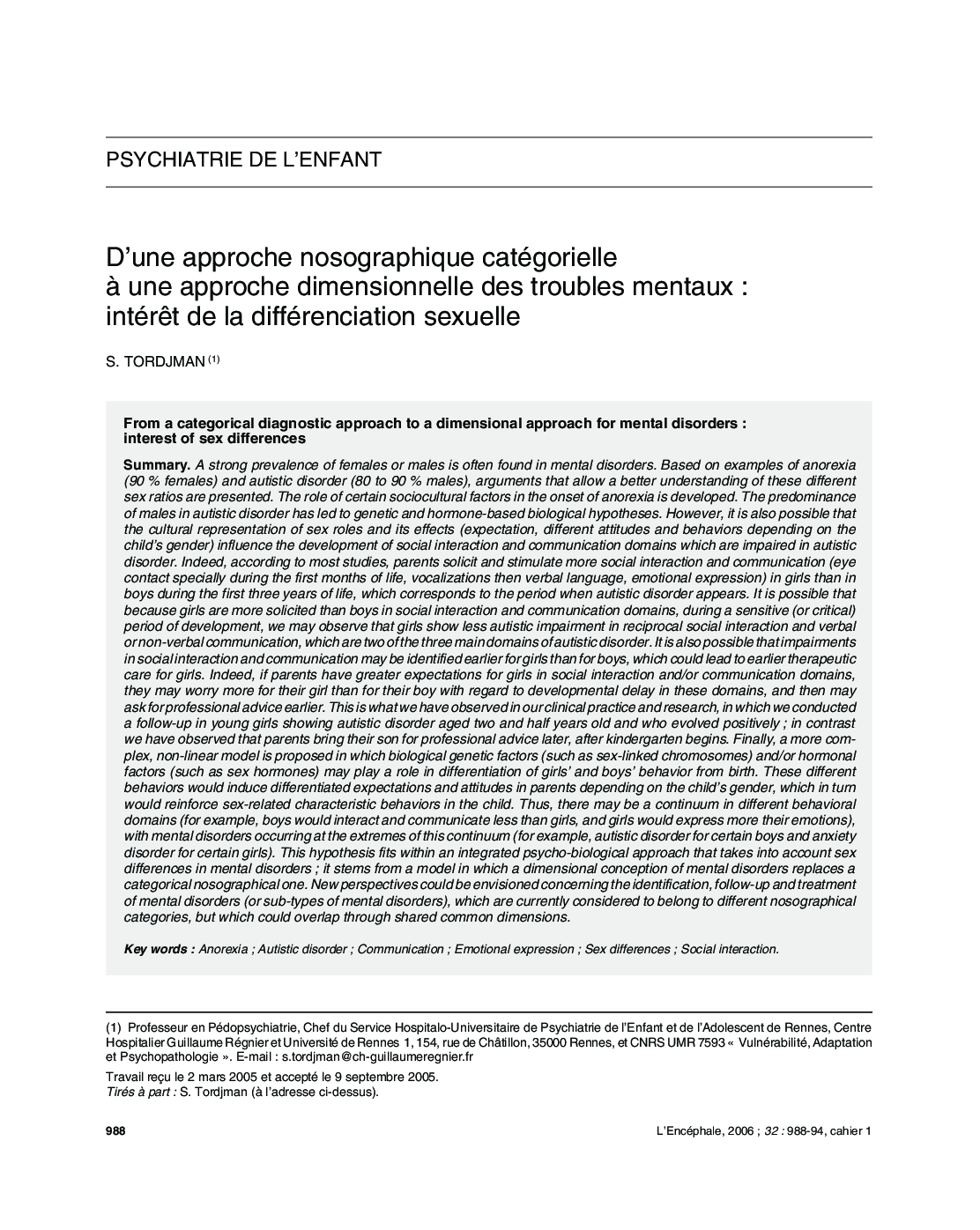| کد مقاله | کد نشریه | سال انتشار | مقاله انگلیسی | نسخه تمام متن |
|---|---|---|---|---|
| 4183332 | 1277261 | 2006 | 7 صفحه PDF | دانلود رایگان |
عنوان انگلیسی مقاله ISI
D'une approche nosographique catégorielle à une approche dimensionnelle des troubles mentaux : intérêt de la différenciation sexuelle
دانلود مقاله + سفارش ترجمه
دانلود مقاله ISI انگلیسی
رایگان برای ایرانیان
کلمات کلیدی
موضوعات مرتبط
علوم پزشکی و سلامت
پزشکی و دندانپزشکی
روانپزشکی و بهداشت روانی
پیش نمایش صفحه اول مقاله

چکیده انگلیسی
A strong prevalence of females or males is often found in mental disorders. Based on examples of anorexia (90 % females) and autistic disorder (80 to 90 % males), arguments that allow a better understanding of these different sex ratios are presented. The role of certain sociocultural factors in the onset of anorexia is developed. The predominance of males in autistic disorder has led to genetic and hormone-based biological hypotheses. However, it is also possible that the cultural representation of sex roles and its effects (expectation, different attitudes and behaviors depending on the child's gender) influence the development of social interaction and communication domains which are impaired in autistic disorder. Indeed, according to most studies, parents solicit and stimulate more social interaction and communication (eye contact specially during the first months of life, vocalizations then verbal language, emotional expression) in girls than in boys during the first three years of life, which corresponds to the period when autistic disorder appears. It is possible that because girls are more solicited than boys in social interaction and communication domains, during a sensitive (or critical) period of development, we may observe that girls show less autistic impairment in reciprocal social interaction and verbal or non-verbal communication, which are two of the three main domains of autistic disorder. It is also possible that impairments in social interaction and communication may be identified earlier for girls than for boys, which could lead to earlier therapeutic care for girls. Indeed, if parents have greater expectations for girls in social interaction and/or communication domains, they may worry more for their girl than for their boy with regard to developmental delay in these domains, and then may ask for professional advice earlier. This is what we have observed in our clinical practice and research, in which we conducted a follow-up in young girls showing autistic disorder aged two and half years old and who evolved positively ; in contrast we have observed that parents bring their son for professional advice later, after kindergarten begins. Finally, a more complex, non-linear model is proposed in which biological genetic factors (such as sex-linked chromosomes) and/or hormonal factors (such as sex hormones) may play a role in differentiation of girls' and boys' behavior from birth. These different behaviors would induce differentiated expectations and attitudes in parents depending on the child's gender, which in turn would reinforce sex-related characteristic behaviors in the child. Thus, there may be a continuum in different behavioral domains (for example, boys would interact and communicate less than girls, and girls would express more their emotions), with mental disorders occurring at the extremes of this continuum (for example, autistic disorder for certain boys and anxiety disorder for certain girls). This hypothesis fits within an integrated psycho-biological approach that takes into account sex differences in mental disorders ; it stems from a model in which a dimensional conception of mental disorders replaces a categorical nosographical one. New perspectives could be envisioned concerning the identification, follow-up and treatment of mental disorders (or sub-types of mental disorders), which are currently considered to belong to different nosographical categories, but which could overlap through shared common dimensions.
ناشر
Database: Elsevier - ScienceDirect (ساینس دایرکت)
Journal: L'Encéphale - Volume 32, Issue 6, Part 1, December 2006, Pages 988-994
Journal: L'Encéphale - Volume 32, Issue 6, Part 1, December 2006, Pages 988-994
نویسندگان
S. Tordjman,